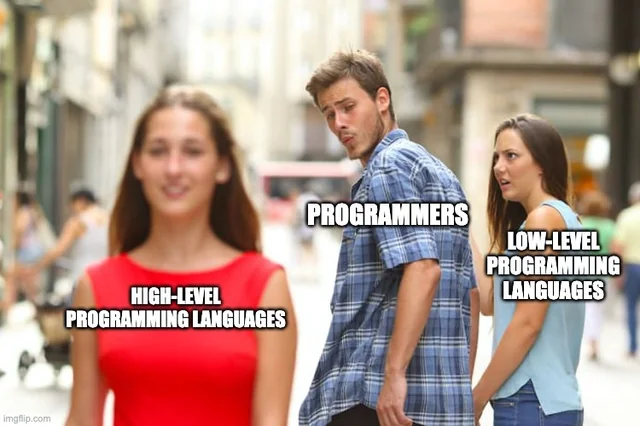Programming languages act as the bridge between human thought and machine action. They allow us to command computers to perform tasks, from displaying a message to running artificial intelligence algorithms. But not all programming languages are created equal—some are closer to how machines operate, while others are designed to be more intuitive for humans.
This distinction brings us to the two broad categories of programming languages: high-level and low-level languages.
Sponsored
Understanding the difference between these categories is essential for developers, especially when deciding which language to learn or use for a particular project. In this article, we’ll explore what defines high-level and low-level languages, their characteristics, real-world examples, and when to use each.
What Is a High-Level Programming Language?
A high-level programming language is designed to be easy for humans to read and write. These languages abstract away much of the hardware-specific details that low-level languages deal with.
They are often platform-independent, meaning you can run the same code on multiple systems with little or no modification. High-level languages focus on logic and functionality rather than memory management and CPU instructions.
Examples of High-Level Languages
- Python
- Java
- C#
- JavaScript
- Ruby
Here’s a simple example of a high-level program in Python:
def greet(name):
print(f"Hello, {name}!")
greet("Alice")This code is concise, readable, and expresses the developer’s intent clearly.
What Is a Low-Level Programming Language?
Low-level languages are closer to machine language. They offer little to no abstraction from a computer’s instruction set architecture (ISA). These languages give the programmer more control over hardware, which can lead to better performance and more efficient memory usage, but they require a deeper understanding of how computers work.
Categories of Low-Level Languages
- Machine Language (First Generation)
- Written in binary (0s and 1s)
- Directly executed by the CPU
- Extremely difficult to write and debug
- Assembly Language (Second Generation)
- Uses mnemonics (e.g., MOV, ADD) instead of binary
- Each assembly instruction maps directly to a machine instruction
- Still requires intimate knowledge of the hardware
Example in Assembly (x86 syntax)
section .data
msg db 'Hello, World!', 0
section .text
global _start
_start:
mov edx, 13 ; message length
mov ecx, msg ; message to write
mov ebx, 1 ; file descriptor (stdout)
mov eax, 4 ; syscall number (sys_write)
int 0x80 ; call kernel
mov eax, 1 ; syscall number (sys_exit)
xor ebx, ebx ; exit code 0
int 0x80Compared to Python, this assembly example is much more complex and hardware-specific.
Key Differences Between High-Level and Low-Level Languages
1. Level of Abstraction
- High-level languages abstract hardware details.
- Low-level languages are close to the hardware and provide minimal abstraction.
2. Ease of Use
- High-level languages are easier to learn, write, and debug.
- Low-level languages require deep understanding of computer architecture.
3. Performance
- Low-level languages offer better performance and memory management.
- High-level languages may be slower due to the overhead of abstraction and interpretation.
4. Portability
- High-level code is often platform-independent.
- Low-level code is usually platform-specific and tightly coupled to hardware.
5. Translation
- High-level languages require a compiler or interpreter.
- Low-level languages like assembly are assembled directly into machine code.
Real-World Applications
High-Level Language Use Cases
- Web development (JavaScript, Python)
- Mobile apps (Java, Kotlin, Swift)
- Enterprise applications (C#, Java)
- AI and Data Science (Python, R)
Low-Level Language Use Cases
- Operating system development (C, Assembly)
- Embedded systems and firmware
- Device drivers
- Real-time systems where timing and performance are critical
The Middle Ground: C Language
C is often referred to as a “mid-level” language. It combines low-level access to memory and system processes with high-level constructs like functions and loops.
Example in C:
#include <stdio.h>
int main() {
printf("Hello, World!\n");
return 0;
}This code is readable and portable but also compiles directly to efficient machine code.
High-Level vs Low-Level: Which One Should You Learn?
It depends on your goals:
- If you want to build web applications, mobile apps, or work in data science, start with a high-level language like Python or JavaScript.
- If you’re interested in systems programming, operating systems, or embedded systems, learning C or Assembly is beneficial.
- Even if you’re working primarily in high-level languages, understanding low-level concepts can make you a better developer.
How High-Level Languages Run Under the Hood
High-level languages go through a transformation process before the computer can execute them:
- Compiler (Java, C, C++)
- Translates source code into machine code or bytecode
- Interpreter (Python, Ruby)
- Executes the code line-by-line using an interpreter
- Hybrid (Java, .NET)
- Compiles to bytecode which is then executed by a virtual machine (JVM, CLR)
Understanding the Trade-Offs
High-level languages boost productivity but often come with performance overhead. Low-level languages require more effort and knowledge but can squeeze out every ounce of performance from the hardware.
The modern development landscape often requires both:
- High-level languages for business logic and user interfaces
- Low-level languages for system-level tasks
Final Thoughts
High-level and low-level programming languages serve different purposes in the software development ecosystem. High-level languages empower developers to build complex applications quickly and efficiently. Low-level languages provide the control and precision needed for performance-critical systems.
Whether you’re writing high-level scripts or diving into the binary world of assembly, understanding the difference between these two types of languages gives you a clearer picture of the programming universe.



